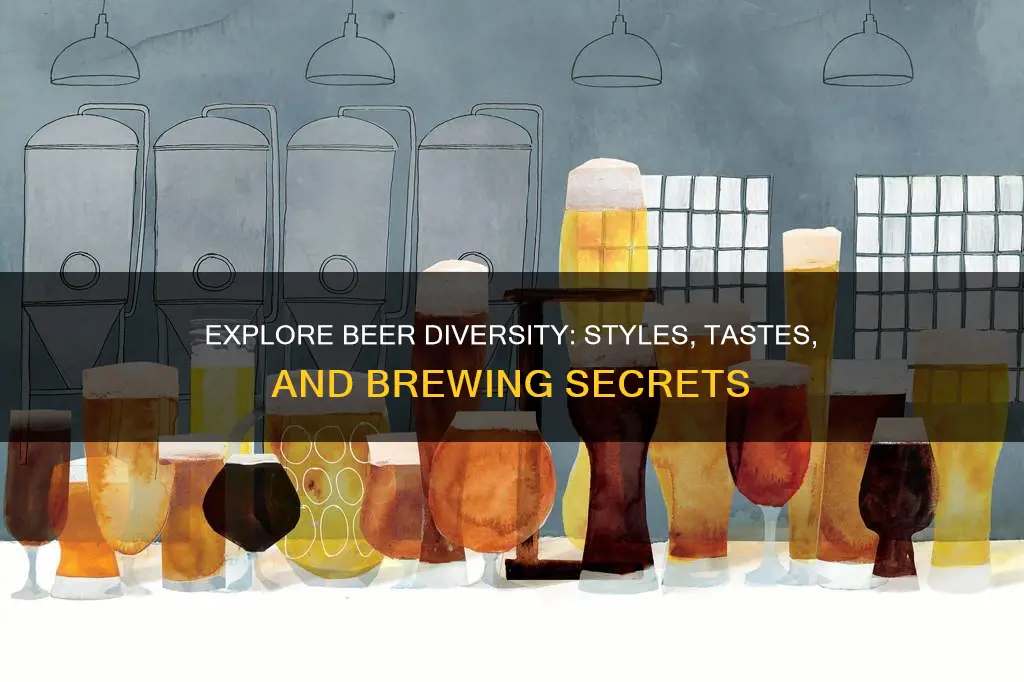
Beer is an alcoholic beverage that has been enjoyed for thousands of years, with evidence of its consumption dating back to the Sumerian civilisation. Over time, and with experimentation, hundreds of different varieties of beer have been created and are now consumed around the world.
The two most generic and high-level categories of beer are lager and ale. The difference between these two types comes down to the type of yeast used during the fermentation process. Lager yeast ferments at the bottom of the vessel in cold temperatures, while ale yeast ferments at the top of the vessel in warm temperatures.
Lagers are typically lighter in colour and have a milder flavour, while ales are darker and have a richer, more complex taste. However, there are many subcategories and variations within these two main types of beer, and the line between lager and ale is often blurred.
What You'll Learn

Ales vs Lagers
Ales and lagers are the two main categories of beer. While there are many different types of beer, they will fall into either the ale or lager category. The difference between the two is the type of yeast and fermentation technique used.
Ales are fermented with top-fermenting yeast at warm temperatures (60˚–75˚F). This means that the yeast rises to the top of the vessel during fermentation, creating a foamy layer. Ales can generally ferment and age in a relatively short period of time (3-5 weeks).
Lagers, on the other hand, are fermented with bottom-fermenting yeast at cold temperatures (35˚–55˚F). The yeast sinks to the bottom of the vessel during fermentation, and the colder temperature slows down the fermentation process, producing less foaming. Lagers take much longer to ferment (up to 6 to 8 weeks).
The different fermentation techniques also result in different flavours. Ales tend to have strong fruity and spicy flavours, while lagers have a 'cleaner' taste that allows the malt and hops to be more noticeable.
In the past, ales were the most common type of beer as they were easier to brew without modern refrigeration technology. However, with the advent of refrigeration in the 1800s, lagers rose in popularity and became the dominant type of beer. Today, both ales and lagers are widely available and enjoyed by beer drinkers around the world.
Crunchy Coatings: Tempura vs Beer Batter
You may want to see also

Fermentation and Yeast
Fermentation is the process by which yeast converts the glucose in the wort to ethyl alcohol and carbon dioxide gas, giving the beer its alcohol content and carbonation. The process was named fermentation, from the Latin word fervere, which means "to boil", as the ancient people observed that mixtures of crushed grapes kept in large vessels produced bubbles, as though they were boiling.
The earliest chemically confirmed barley beer to date was discovered at Godin Tepe in the central Zagros Mountains of Iran, where fragments of a jug, at least 5,000 years old, were found to be coated with beerstone, a by-product of the brewing process. However, it was not until the second half of the 19th century that the role of yeast in the biological transformation of sugars to beer was fully recognised.
Yeast is a tiny, one-celled eukaryotic fungus that is invisible to the naked eye. In the seventeenth century, a Dutch tradesman named Antoni van Leeuwenhoek developed high-quality lenses and was able to observe yeast for the first time. In 1835, Charles Cagniard de la Tour, a French inventor, observed that during alcoholic fermentation, yeast multiplies by gemmation (budding). His observation confirmed that yeast is a one-celled organism and suggested that it was closely related to the fermentation process.
In the 1850s and 1860s, the French chemist and microbiologist Louis Pasteur became the first scientist to study fermentation, when he demonstrated that this process was performed by living cells. Pasteur was the first to demonstrate experimentally that fermented beverages result from the action of living yeast transforming glucose into ethanol. Moreover, he showed that only microorganisms are capable of converting sugars into alcohol from grape juice and that the process occurs in the absence of oxygen.
The two main types of yeast used in brewing are Saccharomyces cerevisiae, known as ale yeast, and Saccharomyces pastorianus, known as lager yeast. Ale yeast is applied to the top of the wort and at a higher temperature, usually between 15 and 20°C (59 and 68°F). Lager yeast, on the other hand, works at the bottom of the wort and at a much lower temperature, usually around 10°C (50°F).
The specific strain of yeast is critical to the outcome of the fermentation, not only in its ability to metabolise the wort contents to produce alcohol and distinctive flavour characteristics but also in its capacity to tolerate its own products of metabolism, most notably alcohol. The yeast used to ferment is usually one or several generations old and, as a consequence of storage prior to pitching and the physiological condition at the end of the previous fermentation, it is depleted of nutrients for growth and fermentation. It requires the stimulus of fresh wort nutrients, particularly oxygen, to rebuild its nutrient store and recommence growth and multiplication.
Yeast ferments wort in two ways. The first is an anaerobic phase, in which the sugars of the pulp (sucrose, glucose, fructose) are consumed by yeasts using anaerobic respiration to yield carbon dioxide, ethanol, and low amounts of energy. The second is an aerobic phase, which is dominated by lactic and acetic-acid-producing bacteria.
In addition to its use in brewing, yeast fermentation is also used in the production of chemical precursors, global food processing such as coffee and chocolate, and even wastewater processing.
Vodka vs Beer: Different Drunk Feels
You may want to see also

Beer Colour
The colour of beer is influenced by a multitude of factors, from the type of malt used to the length of time it is boiled.
The colour of beer is determined by the colour of the malt used to make it. Malt is coloured by melanin, a rust-red pigment. The darker the malts used, the darker the beer will be. Even small amounts of chocolate (roasted) malt will bring on rapid colour shifts, while pale malts in sufficient quantities can still make for a very dark beer.
The Maillard reaction and caramelization are the two chemical reactions that most influence the colour of beer. The Maillard reaction is a browning process that occurs when you toast bread or sear meat. In beer making, kilning malted barley kicks off the Maillard reaction to produce darker malts such as Special B, chocolate malt, and black patent malt. Caramelization, on the other hand, is a form of pyrolysis: the thermochemical decomposition of sugar without the presence of oxygen.
The colour of beer can also be influenced by factors such as the concentration of proteins and polyphenols, the pH of the solution, and brewhouse procedures. Long boil times and decoction mashes can also darken beer beyond its malts’ calculated SRM potential.
Finally, age can also darken a beer, especially lighter-coloured ones, as oxidation takes its toll.
What Makes Bock Beer Unique and Different?
You may want to see also

Flavour and Mouthfeel
There are three key attributes in the perception of mouthfeel: carbonation, fullness, and aftertaste. Carbonation is often the first attribute perceived in the mouth, felt as a sting or tingle linked to the amount of carbon dioxide in a beer. The type of gas used to pressurise the beer will affect the bubble size and foam volume. Beers with more nitrogen will have tighter, smaller bubbles and a creamier mouthfeel, while those with more carbon dioxide will have larger, chunkier bubbles.
Fullness refers to the perceived weight and flow resistance of a beer, with terms like density and viscosity used to describe it. Beers that lack fullness might be described as "thin", while very full-bodied beers can range from "round" to "syrupy". The final attribute of mouthfeel is the aftertaste, which includes sensations like stickiness, astringency, dryness, bitterness, and oiliness that linger in the mouth after drinking.
The body of a beer is separate from but closely related to mouthfeel. It refers to how heavy, light, sticky, or slick the beer feels on the palate. The body is influenced by the levels of dextrins and medium-length proteins in the beer. A low protein level may be caused by excessively long protein rests, excessive fining, or the addition of large amounts of fermentable sugars. Light body is appropriate for American light lagers and lambics, while malt-accented styles like barleywines and doppelbocks benefit from a thicker body.
The flavour of a beer is heavily influenced by its aromatics, or aroma. What we smell in a glass of beer will impact how we taste it. The style of beer will determine the aromatics, which can include florals, pepper, citrus, bread, raisin, chocolate, pine, grass, toffee, banana, earth, nuts, biscuit, coffee, cloves, and tropical fruit, among others.
Understanding the interplay between flavour, aromatics, and mouthfeel can greatly enhance the experience of drinking and evaluating beer.
Explore the Difference Between Ales and Lagers in Beer
You may want to see also

Alcohol Content
Alcohol by volume (ABV) is the standard way to measure the percentage of alcohol in beer. The ABV of beer can vary widely, with most falling somewhere between 2% and 12% ABV. The ABV of a beer depends on many factors, including the type of beer, the country of origin, and the brewing process.
Standard Beers
Standard beers, including lagers and ales, typically have an ABV between 4% and 6%. However, some beers may have higher or lower concentrations of alcohol. For example, light beers usually have an ABV between 2% and 4%, while malt liquors typically range from 6% to 8% ABV.
Low-Alcohol Beers
Non-alcoholic beers typically have an ABV of 0%, but there are also low-alcohol options available. Beers with an ABV of 2% or 3% are perfect for those who want a bubbly drink without the heavy buzz. These brews offer a hint of mischief while keeping things chill. They are ideal for sunny afternoons, long chats, or when you want to have more than one without any regrets.
High-Alcohol Beers
On the other hand, some specialty beers, such as imperial stouts and barley wines, can have ABVs of 10% or higher. For example, an American barley wine might reach 13% ABV, while a Belgian Trappist ale could have an ABV of 10% or more. These high-ABV beers are not for the faint of heart and should be enjoyed in moderation.
Factors Affecting ABV
The biggest factor influencing the ABV of beer is the amount of fermentable sugar available to the yeast during fermentation. The more sugar there is, the higher the ABV of the finished beer. The primary source of fermentable sugar in most worts is malted barley. Brewers can also adjust the ABV by adding other sources of simple sugars, such as syrups, or using yeast strains that consume more sugar.
Additionally, the country of origin and the brewing process can also affect the ABV of beer. For example, an Ordinary Bitter from England may have an ABV of around 3%, while an American lager might have a higher ABV of 4.2%.
Standard Drink Measurements
It's important to note that a standard drink measurement in the United States is defined as any beverage containing approximately 14 grams of pure alcohol (ethanol). This is roughly equivalent to 12 fluid ounces (355 milliliters) of regular beer with a typical ABV of 5%. However, actual alcohol content can vary between different brands and types of beverages. Therefore, understanding the ABV of beer is crucial for drinking responsibly and ensuring that alcoholic beverages are consumed safely.
Seltzer vs Beer: What Sets These Drinks Apart?
You may want to see also
Frequently asked questions
The two most generic and high-level categories of beer are lager and ale. The difference between the two is the type of yeast used during the fermentation process. Ales use top-fermenting yeast strands, while lagers use bottom-fermenting yeast strands.
Some popular ales include:
- Pale Ale
- India Pale Ale (IPA)
- Stout
- Porter
- Irish Red Ale
- English Bitter Ale
- Belgian Ale
Some popular lagers include:
- Pilsner
- American Light Beer
- Bock
- Märzen







